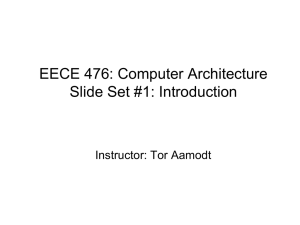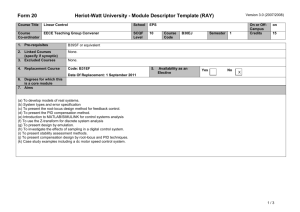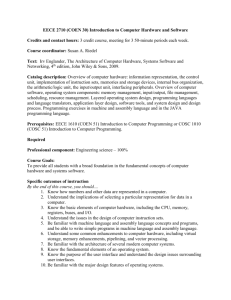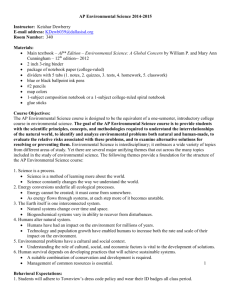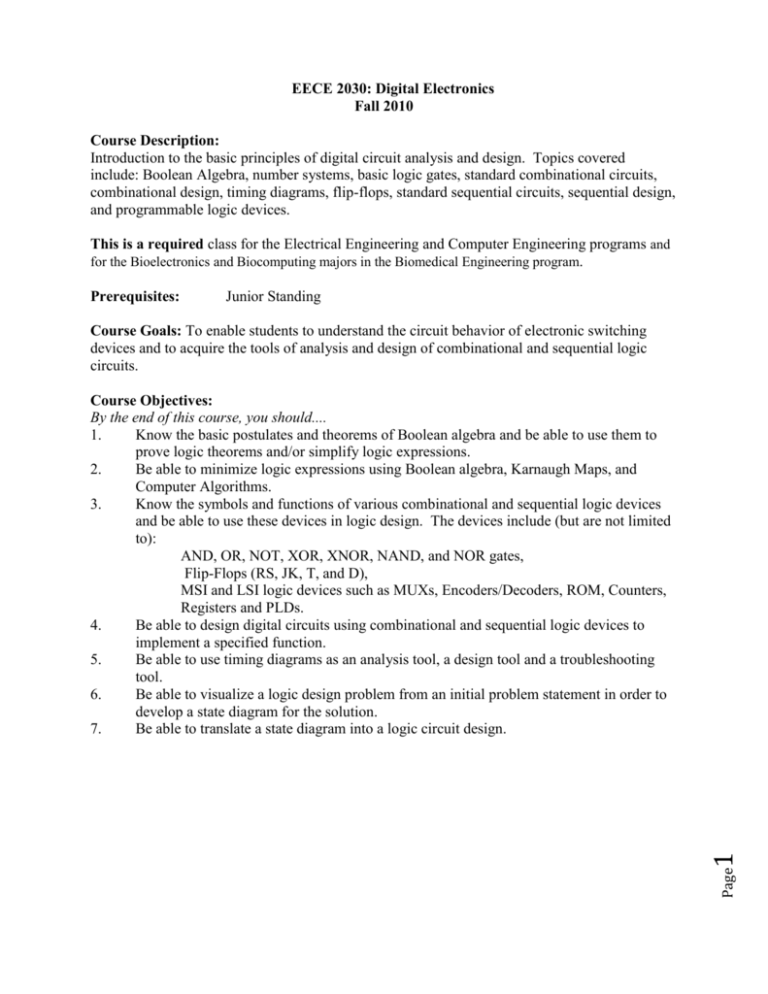
EECE 2030: Digital Electronics
Fall 2010
Course Description:
Introduction to the basic principles of digital circuit analysis and design. Topics covered
include: Boolean Algebra, number systems, basic logic gates, standard combinational circuits,
combinational design, timing diagrams, flip-flops, standard sequential circuits, sequential design,
and programmable logic devices.
This is a required class for the Electrical Engineering and Computer Engineering programs and
for the Bioelectronics and Biocomputing majors in the Biomedical Engineering program.
Prerequisites:
Junior Standing
Course Goals: To enable students to understand the circuit behavior of electronic switching
devices and to acquire the tools of analysis and design of combinational and sequential logic
circuits.
Page
1
Course Objectives:
By the end of this course, you should....
1.
Know the basic postulates and theorems of Boolean algebra and be able to use them to
prove logic theorems and/or simplify logic expressions.
2.
Be able to minimize logic expressions using Boolean algebra, Karnaugh Maps, and
Computer Algorithms.
3.
Know the symbols and functions of various combinational and sequential logic devices
and be able to use these devices in logic design. The devices include (but are not limited
to):
AND, OR, NOT, XOR, XNOR, NAND, and NOR gates,
Flip-Flops (RS, JK, T, and D),
MSI and LSI logic devices such as MUXs, Encoders/Decoders, ROM, Counters,
Registers and PLDs.
4.
Be able to design digital circuits using combinational and sequential logic devices to
implement a specified function.
5.
Be able to use timing diagrams as an analysis tool, a design tool and a troubleshooting
tool.
6.
Be able to visualize a logic design problem from an initial problem statement in order to
develop a state diagram for the solution.
7.
Be able to translate a state diagram into a logic circuit design.
In the Roth Tex
Combinational Logic & Circuits: (40%)
Boolean Algebra
Digital Gates (discrete)
AND/OR/Not
XOR, Equivalence
Minimization Techniques
Minterm/Maxterm expansion
Karnaugh maps
Quine-McCluskey Method
Multi-level circuits, NAND & NOR
MUXs, Decoders, Programmable Devices, ROM
Combination Circuit Design
Sequential Circuits: (45%)
Flip-Flops and Latches
Registers and Counters
Sequential Circuit Analysis & Design
Clocked Sequential Circuit Analysis
Determining State Graphs and Tables
State Table Reduction & State Assignment
Algorithmic State Machine Design
Sequential Circuit Design
Special Topics: (10%)
Arithmetic Circuits (Adders, Multipliers, Dividers)
VHDL, combinational & sequential
Chapter 1
Chapter 1
Chapters 2 and 3
Chapters 2
Chapter 3
Chapter 4
Chapter 5
Chapter 6
Chapter 7
Chapter 9
Chapter 8
Chapter 11
Chapter 12
Chapter 13
Chapter 14
Chapter 15
Chapter 19
Chapter 16
Chapter 18
Chapter 10, 17
2
Introduction/Review: (5%)
Number Systems
Coding Schemes
Page
Digital Electronics Topics:
EECE 2030 – Digital Electronics
Fall 2010
Section
Room:
Instructor:
Office Hours:
Course Web Site
EECE 2030 TAs
EECE TAs with lab
approval authority
101, MWF 2:00 – 3:15 p
EN 128
Dr. Susan C. Schneider
Office: HH 217
Phone: 288-7178
Mailbox: 51
e-mail:
Susan.Schneider@marquette.edu
Office hours for instructor posted on office door, listed in D2L course
site
Other hours available by appointment
If you are registered for this class, you should already be enrolled in
the EECE 2030 course on D2L. Review the material on this site
frequently and check your e-mail DAILY.
An Ji and Xin (Ryan) Wang
Alex Baker, (hopefully others coming soon)
Required Course Materials:
Charles H. Roth, Jr. and Larry L. Kinney, Fundamentals of Logic Design, 6th ed.,
Cengage Learning, 2010. Note - you MUST have the 6th edition, the previous edition is
NOT acceptable. Make sure the textbook also has the enclosed CD – possession of this
CD provides evidence of your license to use the Direct VHDL software.
Software resources including MultiSim (installed on the computers in the Digital lab and
the EECE Open Lab and on the 4th floor) and Direct VHDL (included on the disk
enclosed with the text and installed on all computers in the Digital Electronics Laboratory
and the EECE Open Lab).
EECE 2030 Component Kit.
The protoboard and wiring kit from the EECE sophomore labs. BIEN students should be
able to purchase an equivalent BIEN kit that you will use in subsequent BIEN classes
(see Dr. Schneider for more information).
Laboratory Notebook.
Optional Course Materials:
Marc E. Herniter, Schematic Capture with MultiSim 7, Pearson-Prentice-Hall, 2005.
Page
3
Attendance:
Attendance is expected for all class sessions. Excessive absences WILL result in lower grades.
The maximum number of absences permitted before lowering a final grade is equivalent to 8
classes; each absence beyond this maximum will result in lowering the final grade at the rate of 1
half letter grade per absence.
Ethics Policy:
Any student caught cheating in EECE 2030 will receive an F in the course and be reported to the
chair of the EECE department and the Associate Dean of the College of Engineering.
Cheating includes (but is not necessarily limited to):
a.
Bringing unauthorized materials into the EECE 2030 test area.
b.
Talking to or aiding other students while they are taking a test.
c.
Removing any test, test solutions, homework solutions, or study guide solutions
from the EECE 2030 classroom without prior permission.
d.
Copying any test, lab exercise, design project, or simulation exercise from another
student or downloading a possible solution from the internet.
Grading:
Grading will be on the basis of 1400 total points, broken down as follows:
In Class Exams (7 @ 100 pts)
Cumulative Final Exam
Daily Quizzes (best 20 out of 29, @ 10 pts)
Hands-on laboratory activities
Exercises (2 @ 25 pts)
Design Projects (2 @ 100 pts)
Participation
Extra Credit
Study Guide completion (15 pts max)
DLCI
– or – Module Development (5 pts max)
700
200
200
250
50
Added to final exam score
Added to quiz total score
Lectures and Study Guides - For each unit that will be covered this semester, a brief
introductory lecture on the material will be given. In addition, each chapter (aka unit) in the
textbook has a study guide. The master schedule shows dates for the lectures as well as the dates
by which specific study guide unit problems are to be completed. Students are always expected
to come to class with specific questions related to the materials they are currently studying and
especially so on those days on which no lecture is scheduled.
Page
Tests –
There will be seven (7) tests in this class. Each test will focus on the concepts/topics for several
chapters. The master schedule shows the test dates. In general, auxiliary materials – such as
“cheat sheets” will NOT be allowed for the tests.
Makeup exams will NOT be given. If you are going to be absent from class on a scheduled test
day, please speak with the instructor as soon as possible to arrange to take the test prior to the
scheduled date.
4
Quizzes –
Daily quizzes will be given according to the master schedule. The topics of each quiz will be
determined by the study guide materials that are to be completed on the day of the quiz or were
completed 1 or 2 class days prior. Each quiz is a short problem similar to the study guide
problems and may have multiple parts. Each quiz is worth 10 pts. There will be a total of 28
quizzes during the semester, your final quiz points will be based on your best 20 quizzes.
Lab Exercises and Design Projects:
You will need the EECE 2030 component kit (available in the bookstore) and the tools kit
(protoboard and wiring kit), and cable kit from the EECE sophomore labs to complete these
assignments. All EECE, COEN, and BIOM – Electrical students should already have the tools
and cable kits. BIOM – Computing students may be able to purchase equivalent BIEN lab
component kits which will be used in subsequent BIEN labs – see Dr. Schneider.
Note- all lab assignments should be treated as such. Your preparation work and test
procedures and results should be documented in a laboratory notebook. Your laboratory
notebook will be reviewed as part of the circuit demonstration. The laboratory notebook is the
instrument through which all laboratory work is documented. The items that are traditionally
included in the laboratory notebook are the design work, simulation results, data tables (with
expected values filled in), information about the ICs to be used in the circuits, etc. As we (and
the industry) shift to electronic documentation methods, many of these items are originally
generated electronically and are therefore easily incorporated into an electronic format such as a
Word document or a One-Note workbook for use in preparation (simulations), during lab work
(data entry) and after the laboratory work (analysis, reporting). Design work, however, is
usually still done “by hand” on paper and needs to be archived appropriately. It is
recommended that you use the CoE Laboratory Notebook as your “scratch paper” for the design
phase. Scans of the relevant pages from your ‘paper’ lab notebook can be e-mailed to yourself
using the MFD printers for incorporation into your report. You may also, if you choose, use the
laboratory notebook in the traditional manner for the other aspects such as pasting simulation
results into the notebook, entering data into tables you entered into the laboratory notebook, etc.
Also (highly frowned on!) you could still do your designs on “any ole” scratch paper and then
incorporate the scanned pages into your electronic lab notebook.
You should also evidence good laboratory skills during your demonstration. Good laboratory
skills include (but are not necessarily limited to) neat circuit wiring, neat circuit diagrams (with
IC pins noted on the schematic) and proper test equipment usage!
Page
IMPORTANT – only the EECE 2030 instructor, EECE 2030 TAs or other designated
teaching assistants are allowed to certify successful laboratory demonstrations. This means
that if you happen to get your circuit working in the open lab and the attendant TA is not
authorized to approve your demonstration, you will still need to come to class to demonstrate it
to either an EECE 2030 instructor or one of the EECE 2030 TAs.
5
The following units have associated laboratory assignments. Additional information about each
of the exercises/projects including the rubrics used to assess performance for each of the
laboratory assignments and grade sheets are available from the EECE 2030 D2L site.
Units 4 and 12 have lab exercises for which you will build and test “simple” digital
circuits using discrete gates. A short report is also required. Use MultiSim to complete
any required simulations (NOT LogicAid).
Units 8 and 16 have design projects. For these design projects, you will be using a PAL
device, the GAL16V8. You will need to read supplemental material that will be provided
to you in order to successfully complete the designs. To complete units 8 and 16, you
will need to complete and demonstrate your working design solution to the lab TA (or
instructor) and submit a short design report for grading by the instructor.
Participation - Participation in this class is extremely important and can be evidenced in many
different ways. Coming to every class meeting, asking questions, answering instructor questions
or the questions of fellow students, working collaboratively with other students on problems, are
all ways that an engaged student shows that they are fully participating in the class. To assess
your participation, you will complete a self-evaluation of your participation using the
Participation Rubric form. The instructor will also complete an evaluation of your participation.
Participation will be reviewed TWICE during the semester – at midterm and at the end of class.
The completed self-review Participation Rubric forms are to be uploaded to the appropriate D2L
dropbox on October 20 (midterm) and December 10 (end of semester).
Extra Credit – Homework is neither assigned nor collected in this class. It is expected that all
students will complete the assigned Study Guide problems in a timely manner to remain on
target for quizzes and tests. To reward those students who do develop and maintain good study
habits for this class, extra credit points will be credited for the timely completion of the Study
Guide problems. To earn these extra credit points, students must scan their completed unit study
guides and upload to the appropriate D2L drop box no later than the date shown for each unit on
the master schedule. These study guides will be reviewed by the instructor and/or TAs and those
study guides that show an appropriate amount of correct work will be credited with ONE extra
credit point for each unit completed up to a maximum of 15 points.
The extra credit points will be added to the student’s final exam score.
Grade Scale:
A
AB
B
BC
C
CD
D
93%
89%
85%
80%
75%
70%
65%
Page
(1) EECE 2030 Learning Infrastructure Enhancement will consist of an independent project
by which the student will develop materials for use in this class by future students. Such projects
include, for example, (a) making a video to be posted on D2L which shows how to use the PAL
programmer, or (b) creating additional units/chapters including selected readings (from other
textbooks and/or the internet), with associated study guide materials including problems for
either asynchronous logic design or nano-logic circuits. Students who choose to work on this
project must commit to this extra credit option no later than November 1, 2010, and all materials
for the project must be submitted no later than December 15, 2010. Contact Dr. Schneider if
you are interested in this project.
6
OTHER EXTRA CREDIT – Students will be able to earn an additional 5 extra credit points to
be added to the total quiz score by a ONE of two possible ways: (1) EECE 2030 Learning
Infrastructure Enhancement or (2) participating in the Digital Logic Concept Inventory
evaluation.
Page
7
(2) Digital Logic Concept Inventory Evaluation - Marquette University, EECE Department, (us)
has been asked to participate in a nation-wide evaluation of a “Digital Logic Concept Inventory”
assessment instrument. The DLCI consists of approximately 24 multiple choice questions on
topics which have been covered in this class. The DLCI will take approximately 40 minutes to
complete. This assessment will be scheduled for the last week of class. More details will be
given to you as they become available. You will be required to complete a consent form if you
choose to participate in the evaluation. The scores from the evaluation will be used to assess
student mastery of Digital Logic concepts to inform future pedagogy and will NOT be used for
individual grades.
EECE 2030
MASTER SCHEDULE
Fall 2010
Lectures, Study Guide, Quizzes, Lab Exercises, Design Projects, Tests, D2L db close
3
4
5
6
7
8
9
10
11
12
M
W
F
M
W
F
M
W
F
M
W
F
M
W
F
M
W
F
M
11-Oct
13-Oct
15-Oct
18-Oct
20-Oct
22-Oct
25-Oct
27-Oct
29-Oct
1-Nov
3-Nov
5-Nov
8-Nov
10-Nov
12-Nov
15-Nov
17-Nov
19-Nov
22-Nov
4
5
6
7
9
8
11
12
13
14
15
16
19
18
Study Guide Problems
Unit:Problems
1: all
2:1-8
Labor Day - no class (STUDY)!
2: 9-16, 3:1-4
3:5-7
TEST 1
4:1-11
5:1-5
5:6-10
TEST 2
6:1-4,9
7:1-5
7:5-7
9:1-5
9:6-8
TEST 3
11:1, 2b-f
Quiz
Test
Lab
1
2
1
3
4
2
3
1,2,3
5
6
7
start 4
4
4,5
8
9
10
11
12
11:3b-d,4b-f,5
13
11:(4,5),6b-c,7b,8,9
14
12:1-3
15
12:4-5, 13-1
16
TEST 4
Mid Semester Break (STUDY anyway!)
13:2-5
17
13:6-7
18
14:1-4
19
14:5,6,9
20
TEST 5
15:1
15:2-6
21
15:7-9
22
15:10-11
23
19:all
24
TEST 6
18:1
18:2
25
D2L db
close
4 due
5
6
start 8
7
6,7,9
9
8 due
start 12
11
11,12
12 due
12
13
13,14
14
start 16
15
19
15,19
16 due
8
2
Lecture
on Unit
1
2
3
Page
1
M
W
F
M
W
F
M
W
F
M
W
F
M
W
F
M
W
F
date
30-Aug
1-Sep
3-Sep
6-Sep
8-Sep
10-Sep
13-Sep
15-Sep
17-Sep
20-Sep
22-Sep
24-Sep
27-Sep
29-Sep
1-Oct
4-Oct
6-Oct
8-Oct
EECE 2030
MASTER SCHEDULE
Fall 2010
Lectures, Study Guide, Quizzes, Lab Exercises, Design Projects, Tests, D2L db close
Study Guide Problems
Unit:Problems
Quiz
Test
Lab
D2L db
close
Thanksgiving Holiday (you'd better STUDY)
10
17
8-10 am
18:3
TEST 7
26
10:all
17:all
27
28
18
18
Units 1 - 15
9
W
F
M
14
W
F
M
15
W
F
M
T
W
FINAL Th
F
Lecture
on Unit
Page
13
date
24-Nov
26-Nov
29-Nov
1-Dec
3-Dec
6-Dec
8-Dec
10-Dec
15-Dec
14-Dec
15-Dec
16-Dec
17-Dec

